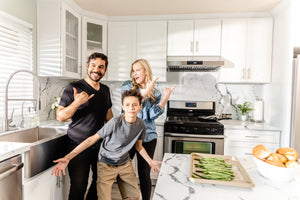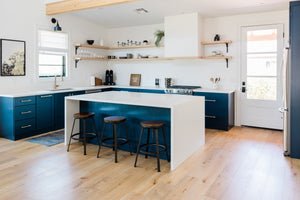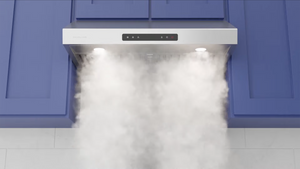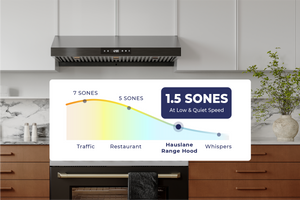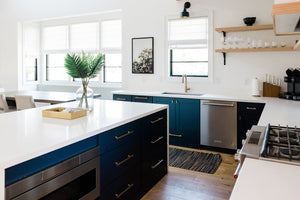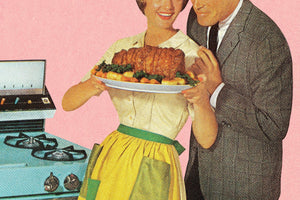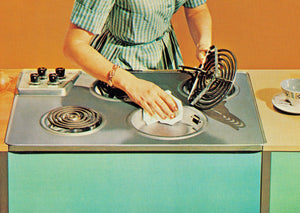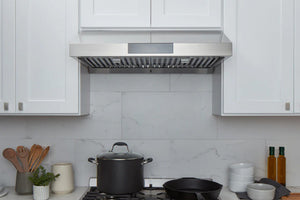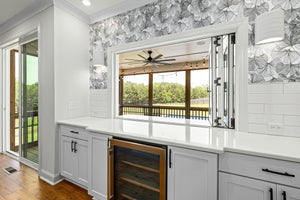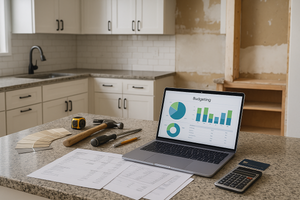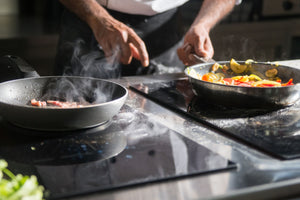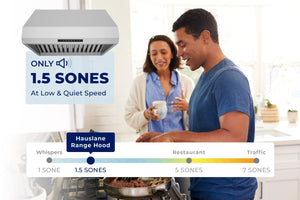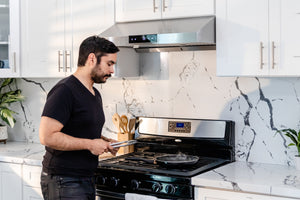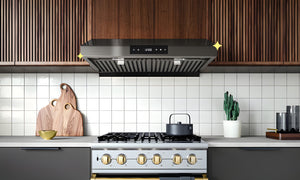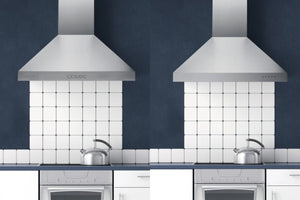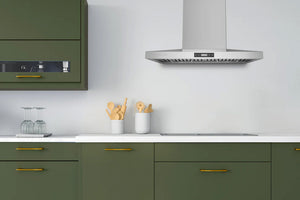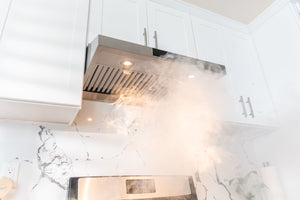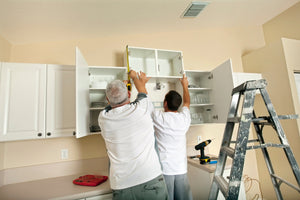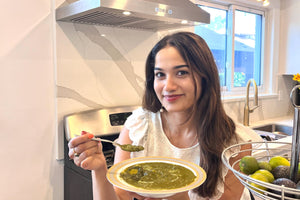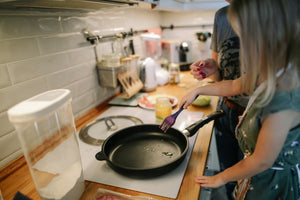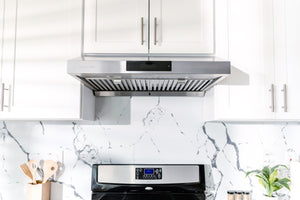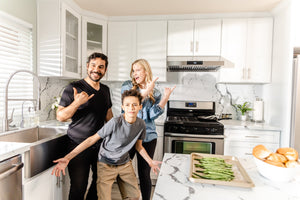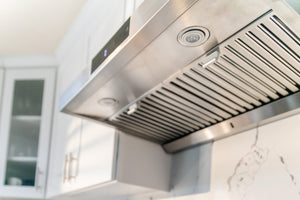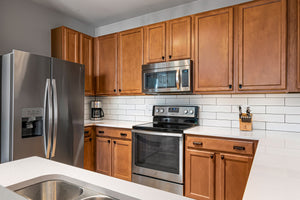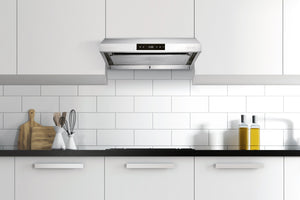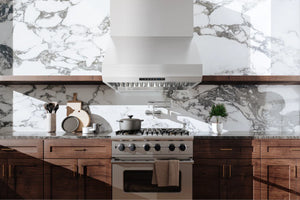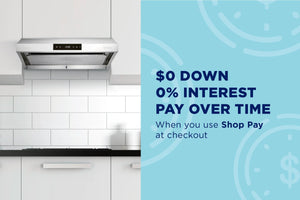TIPS & GUIDES
CFM Requirements for Range Hoods
How Many CFM Do I Need For My Range Hood?
By Hauslane ∙ 15 mins readWhen you consider all the things that affect the air quality inside your home while you’re cooking, having a quality range hood makes perfect sense. All the gunk – steam, smoke, food particles, grease – that splatters on your stove can wind up in your air. A good range hood sucks all of it up and filters it out, preventing it from settling into the fabrics in your house and lingering forever. We’ve got lots of information for you about how to choose a range hood. Here, we specifically discuss CFM requirements for your kitchen and cooking style.

What is CFM for Range Hoods?
CFM means cubic feet of air moved per minute. Simply put, it’s the amount of air a ventilation hood fan is capable of removing through its filter every minute. The fan has to be powerful enough to cover the cooking area and suck up all that potential pollution but not so loud you feel like you’re cooking next to a jet engine.
How to Calculate the Right CFM for Your Home
You can figure out your CFM requirements in several different ways, considering the size of your range, the size of the room, the layout of your kitchen, and the different types of range hoods you’re considering. Here’s what you need to consider:
✦ Type of range hood
✦ Type of stove – electric or gas
✦ Room size
✦ Ductwork
Ducted Range Hoods for Electric Cooktops
Wall-mounted & Under-cabinet range hoods – 100 CFM for every linear foot of cooktop. Most common types of cooktops measure 30 inches wide or 2.5’. To meet the recommended CFM requirements, you’ll need a range hood with 250 CFM. The Hauslane UC-PS18 Ducted Under Cabinet is a good option.
Example: 2.5’ wide cooktop x 100 CFM = 250 CFM
Island hoods – 150 CFM for every linear foot of cooktop. Due to the open nature of a kitchen island stove, you need extra power. As a general rule of thumb, for the same 30” cooktop, you’ll need a range hood with 375 CFM.
Example: 2.5’ wide cooktop x 150 CFM = 375 CFM
While we’ve modeled on an average-sized cooktop, your stove may be as narrow as 20 inches or as wide as a 60-inch commercial model. Measure or check the specs in your user manual to be sure.
Ducted Range Hoods for Gas Cooktops
Gas stovetops can heat up the room more than an electric cooktop. It’s wise to choose a range hood fan with higher CFM if you have a gas stove.
Heat output is measured in BTU, which stands for British Thermal Units. One BTU is the amount of energy needed to heat or cool 1 lb of water by 1°F at sea level. Each burner on your cooktop has a BTU rating (check your user manual).
To calculate the CFM for a gas stove, add the BTU ratings for all burners. Typically, 5,000 to 15,000 per burner is common, and a standard-size four-burner stove will be about 40,000 BTU total. Divide your total by 100 to figure out the CFM you need.
Example: 40,000 BTU ÷ 100 = 400 CFM range hood fan or higher
Room Size for Range Hoods
Next, consider the size of the room. The trend toward open kitchen layouts and higher ceilings influences the extent to which uncaptured particulates can travel. An effective range hood should be capable of exchanging the air in the kitchen every 4 minutes (15 times per hour) by volume to keep your indoor air clean.
For example, if you have an open-concept home, your kitchen may be located in a 20’ x 20’ room with 10’ ceilings.
20’ x 20’ x 10’ = 4,000 cubic feet
To figure the CFM needed for your size kitchen, divide the cubic feet by 4 (minutes)
4,000 ÷ 4 = 1,000 CFM range hood (or higher)
Ductwork
Finally, you need to consider your ducts. Since your fan must pull the air through the filter and out through the duct to the vent, the length of the ductwork is an additional consideration. Common ducts are round and about 6 inches in diameter. For each foot of pipe, add one additional CFM. If the pipe has elbow bends, add 25 CFM for each, plus 40 CFM for the cap.
How to Decide On A CFM Number
With all the different factors to consider, which calculation is the right one? Simple. Pick the biggest CFM number. Look for a range hood that offers all the power you need and offers a quiet operation. Other features to look for include variable fan speeds, dishwasher-safe baffle filters, touch panel operation, energy-saving LED light, and of course, a hood style that fits your aesthetic.
Hauslane range hoods offer high-performance range hoods that will work for most of kitchens. Blowers in Hauslane range hoods approach or exceed professional grade. This keeps your home healthy and smoke/odor-free, even when running your cooktop at max capacity. To learn more about CFM, check out our article, “Is CFM Accurate?”
Can a Range Hood be too Powerful?
Yes, it’s possible to have a range hood that is too big or too powerful for your needs. There are a few problems that can occur if you have a range hood with too much CFM for your kitchen:
✦ Noise: A range hood with high CFM will generally make more noise due to the blower.
✦ Reduced oxygen: A range hood with too much CFM will suck out a lot of air in your kitchen; you may need a make-up air kit to make up for the excessive removal of air.
✦ Maintenance: A high-powered range hood will need more maintenance than one that is appropriately sized for your kitchen. This will only incur more costs and time on your part. They also cost more to repair and replace than smaller range hoods.
✦ Higher energy costs: Range hood with higher CFM and stronger blowers will use more energy, meaning you’ll be paying for something you really don’t need.
Is 400 CFM Enough For a Range Hood or Do You Need 900 CFM?
Determining how much CFM you need depends on two factors: the size of your kitchen and the BTU of your cooktop if you have a gas cooktop. Above, we explain how to determine just how much CFM you need.
What is a Good CFM Airflow?
Most range hoods for residential kitchens are 200 to 600 CFM. The best way to determine how much airflow you need is to use the formulas we shared above for calculating CFM based on the size of your kitchen and/or BTU of your gas cooktop range. If you’re looking at two options, choose the one with higher CFM. That way, you can run it at lower speeds and still get the performance you need.
Other Factors & Issues to Consider
Ideally, your range hood is the same size as your cooking surface, has a powerful, quiet fan, a good filter, and a vent to the outside. Unfortunately, that is not always the case. Common range hood issues include:
✦ No outside ventilation – in some cases, such as stoves located on the interior wall of an apartment building, exterior ducting is not possible. In that case, you’re likely to have a ductless range hood, which is essentially a fan that pulls cooking air through a filter and expels it back into the room. These are not all created equal.
✦ Your range hood needs to be cleaned – Range hoods need regular cleaning to be effective, and filters need to be replaced or cleaned now and then.
✦ All noise, no pull – Some kitchen ventilation fans are ineffective. They may be loud, but they don’t really accomplish anything. They simply don’t have the CFM to do the job.
✦ You forget to turn it on – For best results, turn on the fan 10-15 minutes before you turn on the stove. Then leave the fan running for about as long after you turn off the stove. This added running time will improve filtration capabilities and reduce the number of contaminants you may inhale.
The Dangers of Not Using Your Kitchen Exhaust Fan
Indoor air pollution is a health risk. In the short term, pollutants can trigger asthma attacks, irritate the eyes, nose, and throat, and cause headaches, dizziness, and fatigue. Temporary effects usually go away on their own with limited exposure, but over the long term, living in a home with a poor ventilation system can result in chronic respiratory diseases, heart disease, cancer, and even death.




